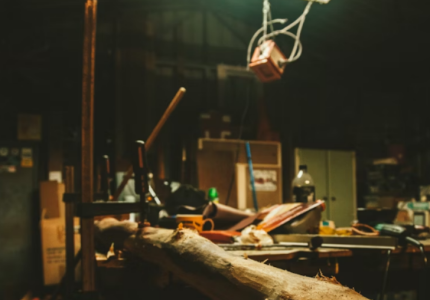19 inventions that happened by accident—but changed the world
- Replies 0
It's easy to take for granted the myriad objects, foods, and technologies that populate our daily lives. They simply exist, fulfilling their purpose without much thought given to their origins.
Yet, a surprising number of these indispensable items aren't the result of meticulous planning, but rather delightful "happy accidents."
From beloved culinary staples to groundbreaking medical advancements, a remarkable array of serendipitous inventions has profoundly transformed the world as we know it.
Let's explore some of these unexpected discoveries that have left an indelible mark on human history.
1.Potato chips
George Crum, New York chef (1853)
How it was created: When an annoying customer kept sending his plate of French fried potatoes back to the kitchen, claiming they were too soggy and thick, chef George Crum decided to deal with the situation in a rather passive-aggressive way.
He sliced the potatoes super thin, fried them to a crisp, and then drenched them in salt. To the chef's surprise, the picky customer loved them and asked for more.
While there are nay-sayers who claim potato chips existed before Crum served them, Malta, New York, where Crum opened his first restaurant, still recognizes him as the snack's inventor.
2. Slinky
Richard James, Naval engineer (1943)
How it was created: During World War II, Naval engineer Richard James was working with tension springs that could support sensitive instruments aboard ships when he accidentally dropped one. After bouncing off the stack of books to the tabletop and finally to the floor, the spring re-coiled itself and stood upright. The bouncy spring was quite amusing to James as it still is to millions of children today.
3. Chocolate‑chip cookies
Ruth Wakefield, American chef (1930s)
How it was created: Ruth Wakefield owned a tourist lodge called the Toll House Inn in Whitman, Massachusetts. One day while baking chocolate cookies for the guests, Wakefield discovered she was out of baker's chocolate. Instead, she chopped up a bar of sweetened chocolate and mixed it with the cookie dough, thinking it would melt. However, the chocolate didn't melt but just softened. She served them anyway, and they quickly became a hit.
4. Post‑it Notes
Spencer Silver, American chemist (1980)
How it was created: While working on discovering a strong adhesive, Silver created low-tack glue that stuck to objects but could be easily removed without leaving a mark. One of Silver's colleagues used the substance on small pieces of paper to mark his place in a choir hymn book, and the Post-it Note was born.
5. Play‑Doh
Kay Zufall, Brian, Joseph McVicker, Bill Rhodenbaugh (1956)
How it was created: The gooey toy kids have been playing with for decades began as a household cleaning product. In the late 1920s, a soap company, Kutol Products, secured a contract with Kroger grocery stores to produce a ready-to-use wallpaper cleaning product made from flour, water, and salt. By the 1950s, many households stopped using coal to heat their homes, which meant that their wallpaper stayed relatively clean.
To keep the company afloat, they decided to find a new market for the product. Using modified ingredients, Kutol Products repositioned the product as a toy for kids and established Rainbow Crafts Company Inc. to sell Play-Doh.
6. Velcro
George de Mestral, Swiss engineer (1957)
How it was created: While on a hunting trip with his dog, de Mestral noticed burrs stuck to his canine friend's fur. He took some burrs to his laboratory and discovered that the pesky burrs had tiny hooks that enabled them to stick to fabric and fur. He developed a fastening system based on the same concept, and as a result, Velcro was born.
7. Ice‑cream cones
Italo Marchiony, businessman (1904)
How it was created: An ice cream stall at the 1904 World’s Fair was doing so well that they quickly ran out of plates. The stall owner ran to the neighboring waffle stand that was hardly selling anything, asking for help.
The two stand owners came up with the idea of rolling up the waffles and topping them with ice cream. And that is how the ice cream cone was invented.
8. Teflon
Roy Plunkett, chemist (1938)
How it was created: While working for DuPont, Dr. Plunkett was assigned to synthesize non-toxic refrigerants. One day, the chemist and his lab assistant were experimenting with one such alternative refrigerant, tetrafluoroethylene (TFE). They created 100 pounds of TFE and stored the gas in small cylinders.
When Dr.Plunkett opened the valve on one of the cylinders of TFE, nothing came out. The scientist investigated further by cutting the cylinder open, discovering that the gas inside had polymerized into a waxy, white powder.
Dr.Plunkett ran additional tests on the new substance and found four unique properties. TFE was slippery, chemically stable, non-corrosive, and had a very high melting point. DuPont patented the substance, and today we know it as Teflon, the coating on your pan that keeps your pancakes from sticking.
9. Plastic
Leo Hendrik Baekeland, Belgian chemist (1907)
How it was created: Early plastics used for insulation were made of organic materials, primarily Southeast Asian beetles, which were not cheap to import. In 1907, Leo Hendrik Baekeland, while trying to develop a cheaper replacement for shellac, accidentally invented the first synthetic plastic known as Bakelite.
The chemist combined formaldehyde with phenol, a waste product of coal, and subjected the mixture to heat. Inadvertently, he created a polymer that did not melt under heat or stress. This new thermosetting plastic was used for everything from jewelry to phones.
10. Popsicles
Frank Epperson, 11-year-old boy (1905)
How it was created: When soda pop first hit the market, 11-year-old Frank Epperson decided to save money and make his own. He combined powder and water in a cup, stirred it with a stick, and then forgot the concoction on his porch.
The temperature dropped below freezing overnight, and when Epperson woke up the following day, he discovered a frozen mixture with the stirring stick still attached.
After serving the frozen treat at an amusement park for 20 twenty years, Epperson received a patent for the Popsicle.
11. Super‑Glue
Dr. Harry Coover, inventor (1942)
How it was created: During WWII, Dr. Harry Coover was working at Eastman Kodak Laboratories to develop plastic lenses that could form precision sights for military guns, when he accidentally discovered a synthetic adhesive made from cyanoacrylate.
At the time, Coover and his team rejected the compound because it was incredibly sticky and had no use for gun sights. Years later, a research student "rediscovered" Coover's 1942 formula while working on another project for the same company.
That's when Coover decided to bring the discovery to the company's attention, which began selling the product in 1958.
12. Corn flakes
The John and Will Kellogg (1894)
How it was created: Will Kellogg was helping his brother John cook meals for patients at their Battle Creek Sanitarium. The brothers accidentally left a pot of boiled grain on the stove for several days.
Although the mixture turned moldy, the resulting product was thick and dry. They then removed the molded part and created corn flakes.
13. Coca‑Cola
Dr. John S. Pemberton, pharmacist (1892)
How it was created: John Pemberton, a Civil War veteran turned pharmacist, was on a quest to find a cure for headaches. He was working on a concoction made of cola nuts and coca leaves. One day, his lab assistant accidentally mixed the two ingredients with carbonated water. It resulted in one of the world’s most popular drinks, Coca-Cola.
14. Dynamite
Alfred Nobel, Swedish chemist and engineer (1866)
How it was created: While gunpowder and nitroglycerin have been around for ages, they were volatile. Then, a Swedish chemist Alfred Nobel, discovered that mixing nitroglycerin with silica would make a malleable paste called dynamite.
In a metal container containing nitroglycerin, he placed a small wooden detonator containing a black powder charge. When it was lit and exploded, the liquid nitroglycerin would also explode.
15. Microwave ovens
Percy Spencer, Raytheon Corp. engineer (1945)
How it was created: A self-taught engineer, Percy Spencer, was working on a radar project for the defense giant Raytheon. While experimenting with microwave emitters, Spencer discovered that a candy bar in his pocket had melted from the heat. The "Eureka" moment occurred when Spencer put corn into the machine, and as soon as it popped, he knew he had discovered something revolutionary.
16. Matches
John Walker, English chemist and pharmacist (1826)
How it was created: In 1826, a British pharmacist named John Walker discovered a dried lump on the end of a stick while stirring a mix of chemicals. When he tried to scrape the chemicals off, they burst into flames. He marketed the first friction matches as “Friction Lights” and sold them at his pharmacy.
17. Pacemakers
John Hopps, electrical engineer (1960)
How it was created: While conducting research on hypothermia, Hopps was using radio frequency heating to restore body temperature. During this experiment, he realized that artificial stimulation could restart a heart that had stopped beating due to cooling. The lifesaving device, known as the pacemaker, was born from this realization.
18. Safety glass
Édouard Bénédictus, French chemist (1909)
How it was created: While working in his lab one day, Bénédictus accidentally knocked a flask off of his desk which cracked but didn’t shatter. The flask was filled with plastic cellulose nitrate or “liquid plastic” which evaporated and held the now-harmless broken pieces together. This resulted in Bénédictus securing the first patent for safety glass which today is most commonly used in vehicle windshields.
19. Penicillin
Sir Alexander Fleming, scientist (1928 )
How it was created: While working on a study, Fleming added staphylococcus bacteria to Petri dishes before leaving for vacation. When he returned, he discovered mold growing in the dishes. After close inspection, Fleming realized that the mold produced a self-defense chemical that could kill bacteria. It led to one of the greatest discoveries in modern medicine, penicillin, the first antibiotic.
Read next:

Have you experienced a “happy accident” that led to something worthwhile? Share your story in the comments—your tale could inspire the next breakthrough!
Yet, a surprising number of these indispensable items aren't the result of meticulous planning, but rather delightful "happy accidents."
From beloved culinary staples to groundbreaking medical advancements, a remarkable array of serendipitous inventions has profoundly transformed the world as we know it.
Let's explore some of these unexpected discoveries that have left an indelible mark on human history.
1.Potato chips
George Crum, New York chef (1853)
How it was created: When an annoying customer kept sending his plate of French fried potatoes back to the kitchen, claiming they were too soggy and thick, chef George Crum decided to deal with the situation in a rather passive-aggressive way.
He sliced the potatoes super thin, fried them to a crisp, and then drenched them in salt. To the chef's surprise, the picky customer loved them and asked for more.
While there are nay-sayers who claim potato chips existed before Crum served them, Malta, New York, where Crum opened his first restaurant, still recognizes him as the snack's inventor.
2. Slinky
Richard James, Naval engineer (1943)
How it was created: During World War II, Naval engineer Richard James was working with tension springs that could support sensitive instruments aboard ships when he accidentally dropped one. After bouncing off the stack of books to the tabletop and finally to the floor, the spring re-coiled itself and stood upright. The bouncy spring was quite amusing to James as it still is to millions of children today.
3. Chocolate‑chip cookies
Ruth Wakefield, American chef (1930s)
How it was created: Ruth Wakefield owned a tourist lodge called the Toll House Inn in Whitman, Massachusetts. One day while baking chocolate cookies for the guests, Wakefield discovered she was out of baker's chocolate. Instead, she chopped up a bar of sweetened chocolate and mixed it with the cookie dough, thinking it would melt. However, the chocolate didn't melt but just softened. She served them anyway, and they quickly became a hit.
4. Post‑it Notes
Spencer Silver, American chemist (1980)
How it was created: While working on discovering a strong adhesive, Silver created low-tack glue that stuck to objects but could be easily removed without leaving a mark. One of Silver's colleagues used the substance on small pieces of paper to mark his place in a choir hymn book, and the Post-it Note was born.
5. Play‑Doh
Kay Zufall, Brian, Joseph McVicker, Bill Rhodenbaugh (1956)
How it was created: The gooey toy kids have been playing with for decades began as a household cleaning product. In the late 1920s, a soap company, Kutol Products, secured a contract with Kroger grocery stores to produce a ready-to-use wallpaper cleaning product made from flour, water, and salt. By the 1950s, many households stopped using coal to heat their homes, which meant that their wallpaper stayed relatively clean.
To keep the company afloat, they decided to find a new market for the product. Using modified ingredients, Kutol Products repositioned the product as a toy for kids and established Rainbow Crafts Company Inc. to sell Play-Doh.
6. Velcro
George de Mestral, Swiss engineer (1957)
How it was created: While on a hunting trip with his dog, de Mestral noticed burrs stuck to his canine friend's fur. He took some burrs to his laboratory and discovered that the pesky burrs had tiny hooks that enabled them to stick to fabric and fur. He developed a fastening system based on the same concept, and as a result, Velcro was born.
7. Ice‑cream cones
Italo Marchiony, businessman (1904)
How it was created: An ice cream stall at the 1904 World’s Fair was doing so well that they quickly ran out of plates. The stall owner ran to the neighboring waffle stand that was hardly selling anything, asking for help.
The two stand owners came up with the idea of rolling up the waffles and topping them with ice cream. And that is how the ice cream cone was invented.
8. Teflon
Roy Plunkett, chemist (1938)
How it was created: While working for DuPont, Dr. Plunkett was assigned to synthesize non-toxic refrigerants. One day, the chemist and his lab assistant were experimenting with one such alternative refrigerant, tetrafluoroethylene (TFE). They created 100 pounds of TFE and stored the gas in small cylinders.
When Dr.Plunkett opened the valve on one of the cylinders of TFE, nothing came out. The scientist investigated further by cutting the cylinder open, discovering that the gas inside had polymerized into a waxy, white powder.
Dr.Plunkett ran additional tests on the new substance and found four unique properties. TFE was slippery, chemically stable, non-corrosive, and had a very high melting point. DuPont patented the substance, and today we know it as Teflon, the coating on your pan that keeps your pancakes from sticking.
9. Plastic
Leo Hendrik Baekeland, Belgian chemist (1907)
How it was created: Early plastics used for insulation were made of organic materials, primarily Southeast Asian beetles, which were not cheap to import. In 1907, Leo Hendrik Baekeland, while trying to develop a cheaper replacement for shellac, accidentally invented the first synthetic plastic known as Bakelite.
The chemist combined formaldehyde with phenol, a waste product of coal, and subjected the mixture to heat. Inadvertently, he created a polymer that did not melt under heat or stress. This new thermosetting plastic was used for everything from jewelry to phones.
10. Popsicles
Frank Epperson, 11-year-old boy (1905)
How it was created: When soda pop first hit the market, 11-year-old Frank Epperson decided to save money and make his own. He combined powder and water in a cup, stirred it with a stick, and then forgot the concoction on his porch.
The temperature dropped below freezing overnight, and when Epperson woke up the following day, he discovered a frozen mixture with the stirring stick still attached.
After serving the frozen treat at an amusement park for 20 twenty years, Epperson received a patent for the Popsicle.
11. Super‑Glue
Dr. Harry Coover, inventor (1942)
How it was created: During WWII, Dr. Harry Coover was working at Eastman Kodak Laboratories to develop plastic lenses that could form precision sights for military guns, when he accidentally discovered a synthetic adhesive made from cyanoacrylate.
At the time, Coover and his team rejected the compound because it was incredibly sticky and had no use for gun sights. Years later, a research student "rediscovered" Coover's 1942 formula while working on another project for the same company.
That's when Coover decided to bring the discovery to the company's attention, which began selling the product in 1958.
12. Corn flakes
The John and Will Kellogg (1894)
How it was created: Will Kellogg was helping his brother John cook meals for patients at their Battle Creek Sanitarium. The brothers accidentally left a pot of boiled grain on the stove for several days.
Although the mixture turned moldy, the resulting product was thick and dry. They then removed the molded part and created corn flakes.
13. Coca‑Cola
Dr. John S. Pemberton, pharmacist (1892)
How it was created: John Pemberton, a Civil War veteran turned pharmacist, was on a quest to find a cure for headaches. He was working on a concoction made of cola nuts and coca leaves. One day, his lab assistant accidentally mixed the two ingredients with carbonated water. It resulted in one of the world’s most popular drinks, Coca-Cola.
14. Dynamite
Alfred Nobel, Swedish chemist and engineer (1866)
How it was created: While gunpowder and nitroglycerin have been around for ages, they were volatile. Then, a Swedish chemist Alfred Nobel, discovered that mixing nitroglycerin with silica would make a malleable paste called dynamite.
In a metal container containing nitroglycerin, he placed a small wooden detonator containing a black powder charge. When it was lit and exploded, the liquid nitroglycerin would also explode.
15. Microwave ovens
Percy Spencer, Raytheon Corp. engineer (1945)
How it was created: A self-taught engineer, Percy Spencer, was working on a radar project for the defense giant Raytheon. While experimenting with microwave emitters, Spencer discovered that a candy bar in his pocket had melted from the heat. The "Eureka" moment occurred when Spencer put corn into the machine, and as soon as it popped, he knew he had discovered something revolutionary.
16. Matches
John Walker, English chemist and pharmacist (1826)
How it was created: In 1826, a British pharmacist named John Walker discovered a dried lump on the end of a stick while stirring a mix of chemicals. When he tried to scrape the chemicals off, they burst into flames. He marketed the first friction matches as “Friction Lights” and sold them at his pharmacy.
17. Pacemakers
John Hopps, electrical engineer (1960)
How it was created: While conducting research on hypothermia, Hopps was using radio frequency heating to restore body temperature. During this experiment, he realized that artificial stimulation could restart a heart that had stopped beating due to cooling. The lifesaving device, known as the pacemaker, was born from this realization.
18. Safety glass
Édouard Bénédictus, French chemist (1909)
How it was created: While working in his lab one day, Bénédictus accidentally knocked a flask off of his desk which cracked but didn’t shatter. The flask was filled with plastic cellulose nitrate or “liquid plastic” which evaporated and held the now-harmless broken pieces together. This resulted in Bénédictus securing the first patent for safety glass which today is most commonly used in vehicle windshields.
19. Penicillin
Sir Alexander Fleming, scientist (1928 )
How it was created: While working on a study, Fleming added staphylococcus bacteria to Petri dishes before leaving for vacation. When he returned, he discovered mold growing in the dishes. After close inspection, Fleming realized that the mold produced a self-defense chemical that could kill bacteria. It led to one of the greatest discoveries in modern medicine, penicillin, the first antibiotic.
Read next:
- These forgotten finds may be hiding in plain sight—and they could be worth a small fortune
- Are these 7 spots in your home quietly increasing your fire risk?
Key Takeaways
- Many common items—from potato chips to Post‑it Notes and penicillin—were invented by accident.
- Post‑it Notes were created after Spencer Silver’s weak adhesive found new use thanks to Art Fry and recycled scrapbook paper.
- Food staples like corn flakes, Popsicles, and chocolate‑chip cookies were born from kitchen mishaps.
- Accidental inventions span vital innovations—safety glass, pacemakers, and antibiotics among them.







